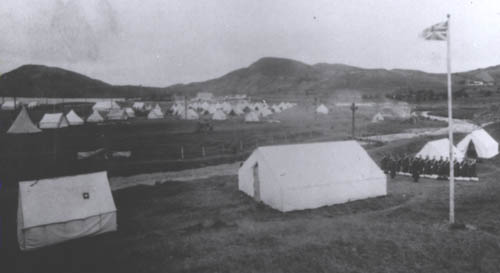World War I
The 1914 declaration of war in Europe cast a dark cloud over the proceedings. It was decided that during times of war there would be no Regatta held, as many of Newfoundland's fine young men would be attached to British combat units, dying for King and Country. It did not feel like a time of celebration for the citizens of Newfoundland. Between 1915 and 1918, no Regatta was held.
The Regatta of 1914 did go ahead, though it did not go ahead as scheduled. The cloud of war seemed to linger over the Regatta. A collision in the first race sent the boat Cadet to its boathouse for repairs by master boat builder Bob Sexton. The weather did not seem to want to cooperate either as a fog and mist hung around the lake, and finally a foul was placed against the Shamrock in the Society Race as someone threw something at an opposing coxswain. All in all, the Regatta of 1914 was one of the most infamous.
|
Shortly after the 1914 Regatta, the call for volunteers went out to the men of Newfoundland.
Where the shores of Quidi Vidi Lake just one month previous held people watching the races, by
September it held the canvas tents of the now famous First Five Hundred
of the First Newfoundland Regiment (later renamed the
Royal Newfoundland Regiment in honour of the acts of bravery
displayed by Newfoundland soldiers). The traditional song of the Regatta,
"The Banks of Newfoundland" (written by Chief Justice Sir Francis Forbes in 1820),
was adopted by the Regiment at this time to serve as its Regimental March. It was
later adopted as the Regatta theme and came to be known as "Up the Pond".
|

Canvas tents set up by the First Five Hundred of the First Newfoundland Regiment (Year: 1914, Source: Regatta Museum).
|
A royal visit
When the Regatta returned in 1919, it returned with a flamboyant style like no other Regatta before it. The people of Newfoundland had come through the war and were now looking to enjoy themselves again. The Victory Regatta of 1919 allowed them to do just that. It was attended by the Prince of Wales, His Royal Highness Edward Albert (later King Edward VIII), who made Newfoundland his first destination after the hostilities had ceased in Europe.
"At about 10:20 AM, His Royal Highness The Prince of Wales
and suite arrived via the south side of the lake, at a point on the
north side opposite the committee marquee. Here a guard of
honour from the Constabulary was in attendance, who, on the
arrival of the Prince, presented arms. The members of the
Regatta Committee were mustered in full force, and the
moment the Prince alighted from his carriage, these, with
general public assembled gave "Three Cheers and a Tiger"
in real Newfoundland style, in welcome to his highness."
-The Daily News, 14th August 1919
This was the second official Royal visit since 1860 when the Regatta
was attended by his grandfather
King Edward VII (Prince of Wales at the time).
After the Prince had left the course, the races continued until the Mercantile Race at one o'clock. It was at this point that tragedy struck at what had been an otherwise perfect Regatta.
Tragedy strikes
The Reid Newfoundland crew, rowing in the six-oared boat Nellie R, had rounded the buoys and were headed to the finish. The wind and waves caused the boat to take on water and, despite constant reassurances from the coxswain, "Shotty" Rogers, four of the crew abandoned. James Kent and L. Morrissey were the first to jump, and they made it to the shore. J. Bell returned to the boat and hung on. But tragically Sgt. Charles Peters drowned almost immediately, despite every effort to rescue him. Once it had been made clear a man had died, the races were stopped in short order and the Regatta Committee wasted no time taking a collection, raising over $1000.00 for his widow.
1922 marked a historic occasion for the Regatta. The famous racing scull The Blue Peter was taken from the waters of Quidi Vidi Lake and presented to the Church Lads Brigade on the 2nd of September, 1922.
"The racer 'Blue Peter' after doing 21 years service on Quidi
Vidi Lake, one of the most successful boats to be used in our
Annual Regatta, will be taken from the CLB Boat house to the
Brigade's Armoury tomorrow evening at 8 o'clock. The members
of the CLB Old Comrades as well as the Battalion Band will be
in attendance while it is expected a large number of citizens will
be taking part in the proceedings. The 'Blue Peter' will be given
a place of honor at the Armoury and it I understood that other
arrangements to perpetuate her victories are in course of
preparation."
-September 1st, 1922
Haig and Coronation
The Regatta of 1924 is commonly known as the Haig Regatta, as it was attended by Field Marshall Earl Douglas Haig, the infamous commander in chief of the Newfoundland Regiment who sent many Newfoundlanders "over the top" during the battle of Beaumont Hamel. Earl Haig was in Newfoundland to unveil a National War Memorial on King's Beach in St.John's, and did so on July 1st, 1924. The Field Marshall then remained in the country long enough to enjoy the 1924 Derby Day.
In 1937, there was another Coronation Regatta. While this is a highlight, it is not the only noteworthy event of 1937. That year, for the first time ever in the history of the Regatta, the Dominion Broadcasting Company broadcast the days events, races and race results. As well a speaker system, provided by Charles Hutton & Sons, was installed for use that day and recorded music was heard for the first time at the Regatta. This would mark the beginning of a new way for people to enjoy the races from around the country of Newfoundland.
(continued on Page 3)





